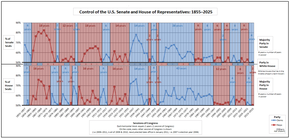This article is missing information about large parts of the U.S. Senate's 20th and 21st-century history. (January 2021) |

| This article is part of a series on the |
| United States Senate |
|---|
 |
| History of the United States Senate |
| Members |
|
|
| Politics and procedure |
| Places |

The United States Senate is the upper chamber of the United States Congress, which along with the United States House of Representatives—the lower chamber—comprises the legislative branch of the federal government of the United States. Like its counterpart, the Senate was established by the United States Constitution and convened for its first meeting on March 4, 1789 at Federal Hall in New York City. The history of the institution begins prior to that date, at the 1787 Constitutional Convention, in James Madison's Virginia Plan, which proposed a bicameral national legislature, and in the controversial Connecticut Compromise, a 5–4 vote that gave small-population states disproportionate power in the Senate.